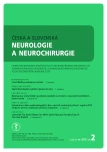Habituation is more Accentuated by Motion-Onset Stimuli than Compared with Pattern Reversal Stimuli – a Pilot Study
Authors:
M. Bednář 1; J. Kremláček 2,3; Z. Kubová 2; R. Taláb 4
Authors‘ workplace:
Rehabilitační klinika LF UK a FN Hradec Králové
1; Ústav patologické fyziologie LF UK v Hradci Králové
2; Neurologická klinika LF UK a FN Hradec Králové
3; LF UK v Hradci Králové
4
Published in:
Cesk Slov Neurol N 2013; 76/109(2): 169-174
Category:
Original Paper
Overview
Introduction:
Assessment of habituation (reduced response to repeated stimuli) using visual evoked potential (VEP) amplitudes represents an innovative and so far infrequent application of VEP that, nevertheless, has a potential to be used in research across all disciplines of neuroscience.
Objective:
The aim of this study was to verify applicability of VEP in assessing habituation and to identify types of visual stimuli (motion versus structural with low or high contrast) that would be the most useful in specific cases.
Methods:
A study group of 12 healthy volunteers (9 women, 3 men) aged 22–39 years was tested using three kinds of VEP – Pattern Reversal VEP (PR-VEP) with 14% and 85% luminance contrasts, respectively, and Motion-onset VEP (M-VEP). VEPs were recorded in 5 blocks of 60 responses.
Results:
The study evaluated amplitude variations of the main components of each type of VEP. Despite high variability in the results and with an exception of the high contrast stimulus, a statistically significant association was found between the time factor and VEP amplitudes (repeated measures ANOVA). Comparison of the mean amplitude of the first and second block of VEPs with the fifthrevealed statistically smaller amplitudes for the M-VEPs. In the pattern reversal stimulation, the amplitude drop was only statistically significant when comparing the second and the fifth block (Wilcoxon paired test).
Conclusion:
M-VEP, as opposed to PR-VEP, seems more suited for the study of habituation.
Key words:
habituation – visual evoked potentials
Sources
1. Rankin CH, Abrams T, Barry RJ, Bhatnagar S, Clayton DF, Colombo J et al. Habituation revisited: an updated and revised description of the behavioral characteristics of habituation. Neurobiol Learn Mem 2009; 92(2): 135–138.
2. Ambrosini A, Schoenen J. Electrophysiological response patterns of primary sensory cortices in migraine. J Headache Pain 2006; 7(6): 377–388.
3. Schoenen J, Wnag W, Albert A, Delawaide PJ. Potentiation instead of habituation characterizes visual evoked potentials in migraine patients between attacks. Eur J Neurol 1995; 2(2): 115–122.
4. Kuba M, Kubova Z. Visual evoked potentials specific for motion onset. Doc Ophthalmol 1992; 80(1): 83–89.
5. Omland PM, Nilsen KB, Sand T. Habituation measured by pattern reversal visual evoked potentials depends more on check size than reversal rate. Clin Neurophysiol 2011; 122(9): 1846–1853.
6. Kremlacek J, Kuba M, Kubova Z, Vit F. Simple and powerful visual stimulus generator. Computer Methods Programs Biomed 1998; 58(2): 175–180.
7. Electrophysiological laboratory [online]. Available from: <http://www.lfhk.cuni.cz/ELF/elf_main.html>.
8. Warren WH jr, Kay BA, Zosh WD, Duchon AP, Sahuc S. Optic flow is used to control human walking. Nat Neurosci 2011; 4(2): 213–216.
9. Coppola G, Pierelli F, Schoenen J. Habituation and migraine. Neurobiol Learn Mem 2009; 92(2): 249–259.
Labels
Paediatric neurology Neurosurgery NeurologyArticle was published in
Czech and Slovak Neurology and Neurosurgery

2013 Issue 2
Most read in this issue
- Creutzfeldt-Jacob disease
- Spinocerebellar Ataxia 7 – a Case Report
- Lyme Borreliosis as a Cause of Bilateral Neuroretinitis with Pronounced Unilateral Stellate Maculopathy in a 8-Year Old Girl
- Electrophysiological Examination of the Pelvic Floor
